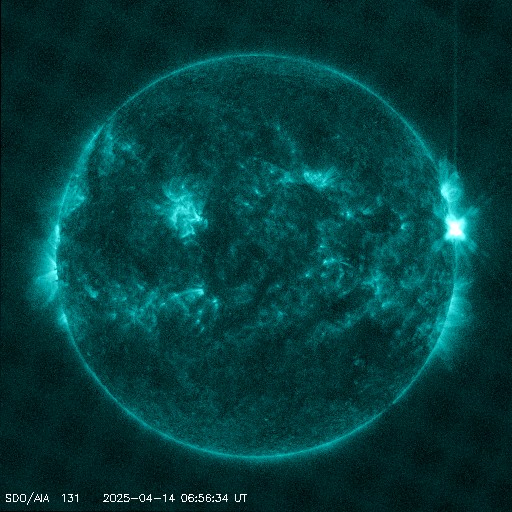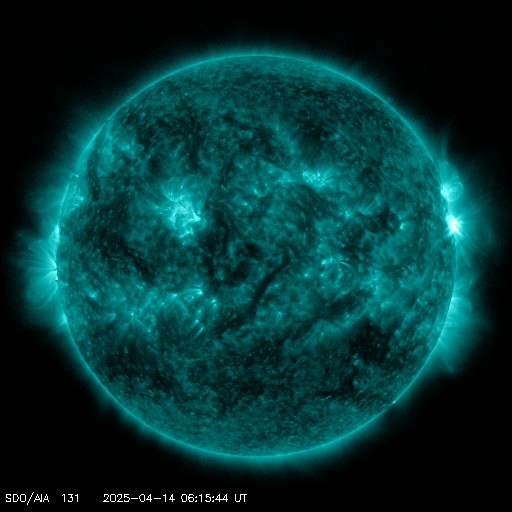Viewing archive of Tuesday, 1 April 2003
Solar activity report
Any mentioned solar flare in this report has a scaling factor applied by the Space Weather Prediction Center (SWPC). Because of the SWPC scaling factor, solar flares are reported as 42% smaller than for the science quality data. The scaling factor has been removed from our archived solar flare data to reflect the true physical units.
Report of Solar-Geophysical Activity 2003 Apr 01 2200 UTCPrepared by the NOAA © SWPC and processed by SpaceWeatherLive.com
Joint USAF/NOAA Report of Solar and Geophysical Activity
SDF Number 091 Issued at 2200Z on 01 Apr 2003IA. Analysis of Solar Active Regions and Activity from 31-2100Z to 01-2100Z
Solar activity was at low levels. There were only two
C-class flares from Regions 323 (S08W43) and 318 (S12W65).
IB. Solar Activity Forecast
Solar activity is expected to be low.
There is a small chance for an isolated M-Class flare from either
Region 323 (S08W43), Region 325 (N12E14), or Region 324 (S11W08).
IIA. Geophysical Activity Summary 31-2100Z to 01-2100Z
The geomagnetic field was at quiet to minor storm levels, with
occasional major storming at high latitudes. The high speed stream
that began early on 30 March continued during the period. The
greater than 2 MeV electrons at geosynchronous orbit reached high
levels.
IIB. Geophysical Activity Forecast
The geomagnetic field is
expected to be at quiet to unsettled levels. The high speed stream
which has impacted earth for the previous two days will pass by day
two.
III. Event Probabilities 02 Apr to 04 Apr
| Class M | 30% | 30% | 30% |
| Class X | 05% | 05% | 05% |
| Proton | 01% | 01% | 01% |
| PCAF | green | ||
IV. Penticton 10.7 cm Flux
Observed 01 Apr 153 Predicted 02 Apr-04 Apr 155/150/145 90 Day Mean 01 Apr 134
V. Geomagnetic A Indices
Observed Afr/Ap 31 Mar 015/031 Estimated Afr/Ap 01 Apr 017/015 Predicted Afr/Ap 02 Apr-04 Apr 010/012-010/010-008/010
VI. Geomagnetic Activity Probabilities 02 Apr to 04 Apr
| A. Middle Latitudes | |||
|---|---|---|---|
| Active | 40% | 30% | 30% |
| Minor storm | 10% | 10% | 10% |
| Major-severe storm | 05% | 05% | 05% |
| B. High Latitudes | |||
|---|---|---|---|
| Active | 45% | 30% | 30% |
| Minor storm | 15% | 10% | 10% |
| Major-severe storm | 10% | 05% | 05% |
All times in UTC
Current data suggests there is a slight possibility for aurora to appear at the following high latitude regions in the near future
NuukReykjavik
Latest news
Latest forum messages
2025/04/12-13 Filament CMEs 2025/04/16 G2 Watch 41AR 4055 99Incoming & Unnumbered Active Regions 1700Unspecified geomagnetic activity 2258Potential AR4062 8
More topicsSupport SpaceWeatherLive.com!
A lot of people come to SpaceWeatherLive to follow the Sun's activity or if there is aurora to be seen, but with more traffic comes higher server costs. Consider a donation if you enjoy SpaceWeatherLive so we can keep the website online!

Latest alerts
Monday, 14 April 2025
23:15 UTC - Geomagnetic activity
Active geomagnetic conditions (Kp4) Threshold Reached: 23:01 UTC
07:09 UTC - Solar flare
Moderate M4.28 flare from sunspot region 4055
06:48 UTC - Radio Blackout
Minor R1 radio blackout in progress (≥M1 - current: M1.53)
06:24 UTC - Solar flare
Moderate M1.49 flare from sunspot region 4055
06:06 UTC - Radio Blackout
Minor R1 radio blackout in progress (≥M1 - current: M1.16)
Space weather facts
| Last X-flare | 2025/03/28 | X1.1 |
| Last M-flare | 2025/04/14 | M4.2 |
| Last geomagnetic storm | 2025/04/06 | Kp5 (G1) |
| Spotless days | |
|---|---|
| Last spotless day | 2022/06/08 |
| Monthly mean Sunspot Number | |
|---|---|
| March 2025 | 134.2 -20.4 |
| April 2025 | 132.1 -2.1 |
| Last 30 days | 130.6 -13.6 |





